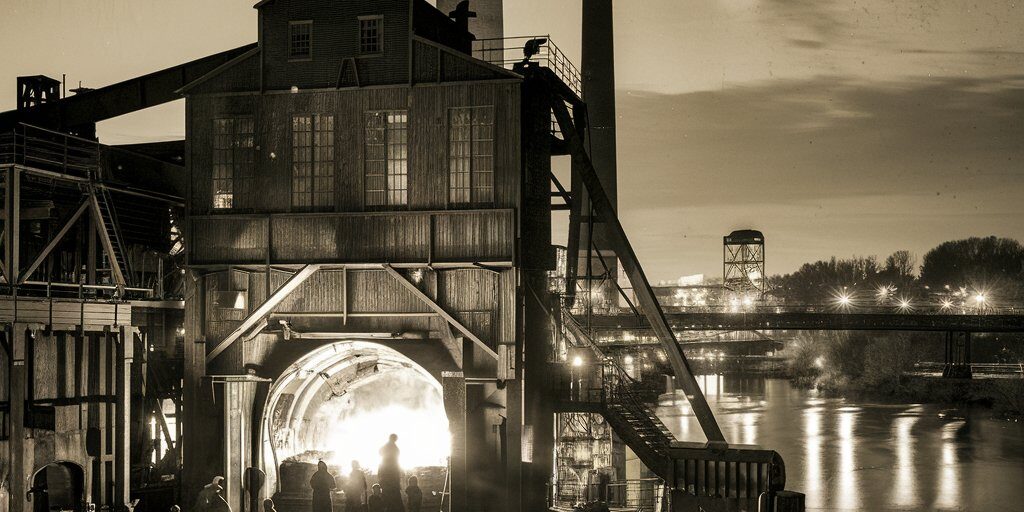Introduction: Before the Steel, There Was Iron
Long before Pittsburgh earned its title as the “Steel City,” it was iron that laid the foundation for the region’s industrial empire. The great bridges, railroads, and machinery of the 19th century were born from the roaring fires of iron furnaces that dotted Pittsburgh’s hills and river valleys.
From small charcoal blast furnaces to towering coke-fed behemoths, Pittsburgh’s iron industry shaped its geography, economy, and identity. This is the story of the city’s earliest industrial boom — a tale of fire, innovation, and transformation that forged the modern world.
Early Beginnings: The Charcoal Iron Age
Pittsburgh’s iron story begins in the late 18th century when the region’s vast forests fueled early charcoal blast furnaces. These small operations smelted bog iron ore found in nearby hills and swamps.
Key Early Sites:
- Schoenberger Furnace (1811): One of Pittsburgh’s first large iron operations.
- Clinton Furnace (1859): Once located near what is now Schenley Park, Clinton was the last charcoal-fueled furnace in Pittsburgh.
Charcoal furnaces produced limited quantities of pig iron, used mostly for tools, nails, and farm equipment.
Early ironmasters like Benjamin Franklin Jones (later of Jones & Laughlin Steel) learned the craft here, paving the way for bigger ambitions.
The Switch to Coke: Fueling the Industrial Revolution
By the mid-19th century, Pittsburgh’s furnaces transitioned from charcoal to bituminous coal and coke, thanks to abundant local supplies.
Coke — a purified coal product — burned hotter and cleaner, allowing for larger furnaces and higher-quality iron. This innovation triggered Pittsburgh’s first industrial boom.
Notable Furnaces:
- Lucy Furnace (1870s): A Jones & Laughlin property, famous for its massive output.
- Eliza Furnace (1845): One of the most advanced of its time, once located along the Monongahela River.
- Carrie Furnaces (1884): Built by Carnegie Steel, these towering blast furnaces became icons of Pittsburgh’s industrial might.
“The smoke from Pittsburgh’s furnaces darkened the sky, but it was the glow of progress.” — Pittsburgh Gazette, 1868
Immigrant Labor and the Furnace Life
The iron boom drew thousands of immigrants — Irish, Welsh, German, Slovak, and Italian — who toiled in unimaginable heat.
Men worked 12-hour shifts, feeding furnaces with ore, coke, and limestone. Temperatures near the hearth exceeded 1500°F. Accidents were common.
“The furnaces eat men as fast as coal.” — Laborer’s Diary, 1882
Neighborhoods sprang up around the mills — Hazelwood, South Side, Homestead — forming tight-knit ethnic enclaves still evident today.
Technological Advancements: From Pig Iron to Steel
As Pittsburgh’s ironmakers perfected their craft, new technologies like the Bessemer Converter (1875) emerged, turning molten pig iron into steel.
Key Transitions:
- Open Hearth Furnaces replaced blast furnaces for steelmaking.
- Ironworks adapted or perished — some integrated into steel mills, others became obsolete.
Pittsburgh’s iron legacy literally melted into the steel empire. But without iron, there would have been no steel.
The Carrie Blast Furnaces: Pittsburgh’s Last Great Iron Monument
Perhaps the most famous surviving relic is the Carrie Blast Furnaces (1884-1982) in Swissvale/Rankin:
- Operated by U.S. Steel’s Homestead Works.
- At peak, produced 1,200 tons of iron daily.
- Now a National Historic Landmark, preserved by Rivers of Steel Heritage Corp.
Today, visitors can walk among the massive rusting structures and feel the scale of Pittsburgh’s iron age.
“These walls saw the birth of an empire — molten rivers that shaped a nation.” — Rivers of Steel Tour Guide
The Decline: Iron’s Fall in the Shadow of Steel
By the early 20th century, steel eclipsed iron. Many standalone iron furnaces shut down or converted.
Factors driving the decline:
- Steel’s superior strength and versatility.
- Cheaper steel production methods.
- Depleted local ore supplies.
The Great Depression sealed the fate of many remaining furnaces. Today, most are gone, their sites now parks, housing, or overgrown ruins.
What Remains: Traces of the Iron Age in Modern Pittsburgh
Places You Can Visit Today:
- Carrie Furnaces: Tour the last standing blast furnaces.
- Schenley Park: Near the site of the old Clinton Furnace.
- Eliza Furnace Trail: Bike path named after the 1845 furnace once at that location.
- Hazelwood Green: Former iron and steel site, now a model of post-industrial rebirth.
Each site offers a glimpse into the forgotten world of Pittsburgh’s ironmasters and furnace men.
Conclusion: Pittsburgh’s Iron Heartbeat
The iron furnaces of Pittsburgh were more than machines — they were the lungs of an industrial beast, breathing fire and forging a new nation.
Though the furnaces fell silent, their legacy lives on in the bridges, buildings, and spirit of Pittsburgh. Every beam of steel that built America was born from iron — and that iron was born in Pittsburgh.
“We were the crucible. The place where rock, fire, and sweat became America.” — Steelworker’s Oral History, 1985








